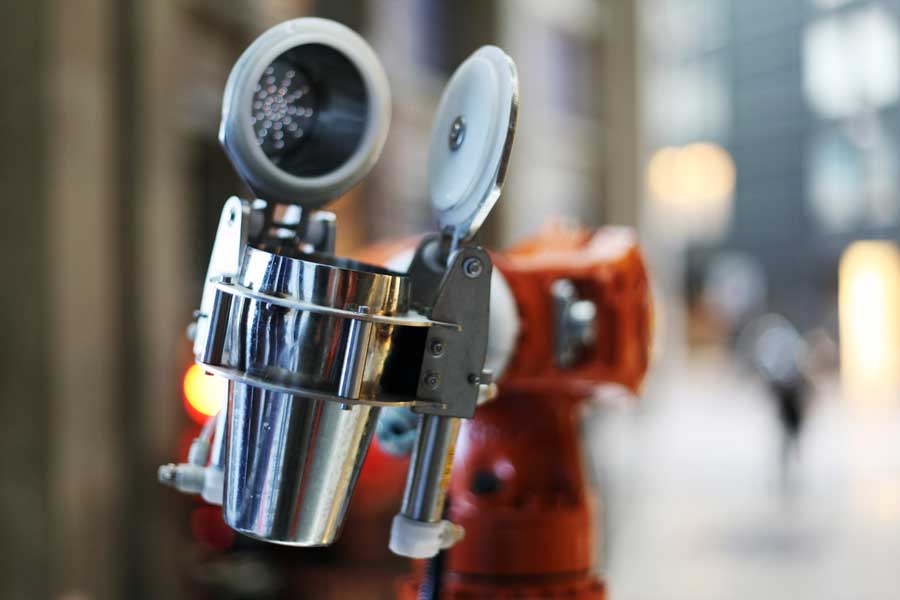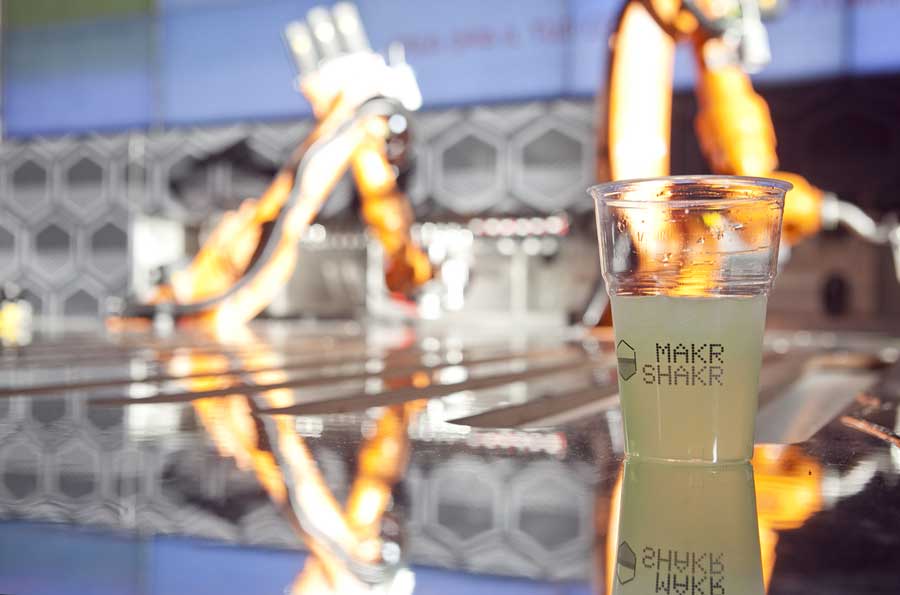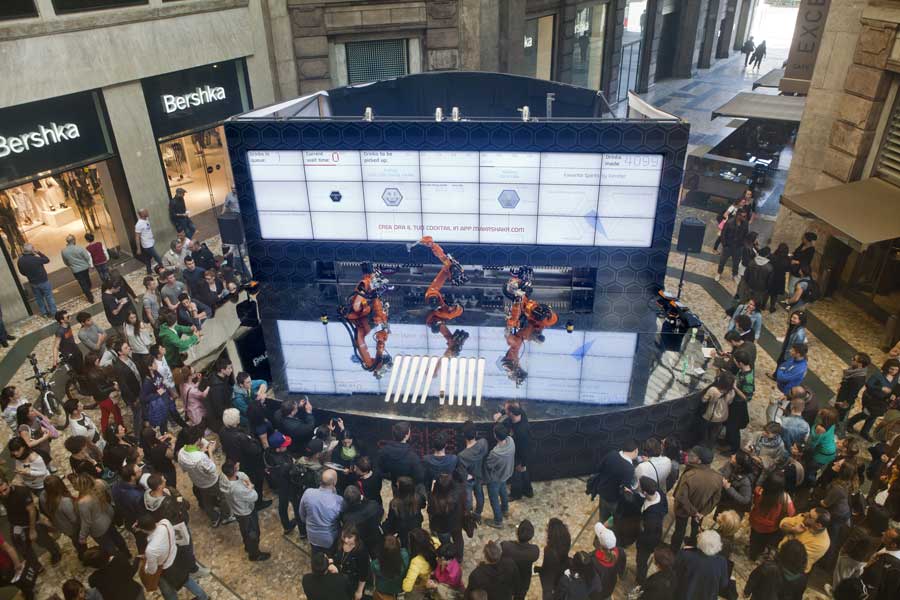
Robohub.org
Robotic bartender assembles personalized drinks, monitors alcohol consumption, and takes social mixing to a whole new level
You’re at a busy bar. You order your personalized cocktail through a smart phone app; a drink dispenser measures out the beverage according to your instructions and a Kuka robotic arm give it a shake (or stir), while another garnishes it with a slice of lemon; the made-to-order concoction is delivered to your waiting hand via a slick little ten-lane conveyor belt. 
The ‘mixology system’ tracks your order from start to finish: a large display behind the bar shows you the number of drinks ahead of yours in the queue, the current wait time, and lets you know when your drink is ready to be picked up. It also shows you what’s popular to drink tonight among both the ladies and the gents in the crowd, and lets you influence drinking trends in realtime by incorporating your suggested tweaks on popular recipes.
This clearly isn’t your parents’ neighbourhood watering hole, but it could be your kids’ — or even yours if you are lucky enough to be at the Google I/O After Hours event tonight in San Francisco. Welcome to Makr Shakr, a bar for the ‘sense-able city’ of tomorrow.
Drink as digitally/socially fabricated meme
Makr Shakr is one of MIT’s SENSEable City Lab projects, where the goal is to study and anticipate how sensor technologies can inform and transform our built environments. The project’s creators say that it’s not about trying to replace bartenders with robots, or even about drinking; it’s about exploring the dynamics of consumption and social networks in the context of sensor and digital fabrication technologies. In other words, its a mini-lab for learning about how we, the social creatures that we are, might interact with each other and our environments in the sensor-augmented cities of tomorrow.
According to project leader Yaniv Turgeman, Makr Shakr was conceived as part research project, part art installation, part social experiment: “It is a research platform aimed at the third industrial revolution, where anyone can design, produce and influence culture. It’s also an installation meant to provoke and question our relationship with technology and creation … we’re experimenting with the idea of social co-creation and consumption.” Given Makr Shakr’s fundamental connection to crowdsourcing and social networks, it’s no wonder, then, that the project was invited to this year’s Google I/O event as a feature project.
As I write this article, Turgeman is busy with last minute preparations for Makr Shakr’s official launch at tonight’s Google I/O After Hours party, but I managed to track him down for a phone interview earlier this afternoon. He explained to me that point of the project was to take the phenomenon of maker culture and learn whether (and how) we can leverage it to socially create “bottom up culture”.
The SENSEable City Lab has many social and sensor networking projects at various stages of development (including elaborate plans for a World Expo 2015 project that will explore how social connectivity can be used to influence the production, distribution, preparation, consumption and recycling of food), but when Google first approached the lab about developing a project specifically for the 2013 I/O event, the team chose Makr Shakr because drinking is a social and relatively discrete (and therefor easy to parameterize) activity; in other words, it’s an ideal context for studying how people interact with digitally-mediated social networks.
“Drinking happens to be a very social activity,” Turgeman said. “At a bar, you’re looking to meet people. You might think ‘hey that’s a great drink I just invented’ and want to share it or iterate on it … by exploring the realtime behavioural dynamics in this situation, maybe we can learn something about how people interact with and influence each other’s consumption habits.”

Digital fabrication is an important theme at the SENSEable City Lab, which regularly partners with industry in order to contextualize researchers where they can conduct real-world experiments. The kind of personalized, just-in-time digital fabrication and delivery exemplified by Makr Shakr (the ‘third industrial revolution’ Turgeman refered to earlier in our conversation) is one that demands that big time players from the food and beverage sector take note. And some already have — in 2009 Coca-Cola launched Freestyle, a touchscreen-operated beverage dispenser that offers more than 100 of the company’s brands in a single dispensing device. But the big idea of Turgeman’s project is not to study delivery systems for custom drinks, it’s to study how cultural memes are created and promoted, and this is surely of interest to major brands like Coke and Bacardi, which are the main sponsors of the project.
In this context, Makr Shakr takes personalized branding to a whole new level. Says Turgeman: “The magic moment will be watching the formation of a bottom-up bar culture, as we close the loop between co-curating and co-producing in real time.” It’s not hard to imagine that, if Makr Shakr one day goes mainstream, advertisers and big brands will want a piece of the action. But as top-heavy players in a bottom-up world, the question that lingers is, will we let them?
Bottom up culture, or Bottoms up culture?

It’s not clear to me during our phone interview whether Turgeman sees the pun in his ‘bottom up’ approach to influencing drinking culture, but it does get me prodding him about the claims on the Makr Shakr website that the system promotes responsible drinking by allowing people to self-monitor their alcohol consumption.
While this feature won’t be operational during the Google I/O event (they are expecting a crowd of 5000+ and didn’t want to overextend the system tonight) Turgeman explained that, yes, Makr Shakr can be used to track a person’s alcohol consumption. There’s no breathalizer unit to blow into (too uncouth, I imagine, not to mention the privacy issues and ick-factor); instead the system estimates your blood alcohol levels based on weight and height information you provide when you install the app on your phone, and the number of drinks that the system has served you.
The Makr Shakr phone app displays your blood alcohol level over time in a chart, but it also uses three simple icons to tell you whether you are safe “to drive, to walk or to talk,” because, as Turgeman points out, numbers might be meaningless to you, especially after a few drinks. “Sometimes you think you’re safe to drive when you’re not. When you’re being social, it’s hard to keep track of how many drinks you’ve had,” says Turgeman, and since that data is so easy to capture, “it’s a no-brainer that of course we should let people know.” He also assures me that, as discretion is a must for bartenders, all data from the Makr Shakr app is anonymous (though users are able to share their age, gender, nationality, nickname and photo or avatar for social networking if they want to).
Though Makr Shakr will not demand that you turn over your car keys and order you a taxi if you’re over the legal limit, Turgeman says that it’s not a stretch that future iterations could interface with taxi-service apps like Uber.
I’m told that Makr Shakr doesn’t take tips, but I’ll tip my hat to its makers all the same.

[Credits: Project concept and design by MIT Senseable City Lab; Implementation bycarlorattiassociati | walter nicolino & carlo ratti; Main partners – Coca-Cola and Barcardi. Technical partners – Kuka, Pentagram, SuperUber; Media partners – Domus, Wired; Videos by MyBossWas; Event in collaboration with Meet the Media Guru, and endorsed by: Comune di Milano, World Expo Milano 2015 – Energy for Life. Feeding the Planet. Photos: Lucas Werthein, Max Tomasinelli, My Boss Was. Full credits available at www.makrshakr.com.]
If you liked this article, you may also be interested in:
- The death of search (or, My dysfunctional relationship with Siri)
- If you could enhance yourself with some robotic accessory or implant, what would it be?
- Robot tourism coming soon to Korea: Masan Robot Land project finally breaks ground
- Do robots need heads?
See all the latest robotics news on Robohub, or sign up for our weekly newsletter.
tags: c-Arts-Entertainment, cx-Industrial-Automation, cx-Research-Innovation, human-robot interaction, MIT, Sensing


